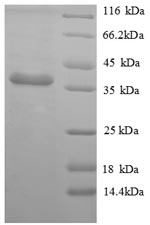Apoe/Apolipoprotein E Protein CSB-EP001936MO is a Recombinant Mouse Apoe, which is the full-length mature protein from amino acid 19 to 311. It is produced in E.coli through Prokaryotic expression and fused with a 6xHis-tag at the N-terminus. And it has high purity of up to 90% as determined by SDS-PAGE. Its predicted molecular weight is 38.0 kDa, but the actual observed molecular mass via SDS-PAGE analysis is a little bit more than 38 kDa due to post-transcriptional modifications such as glycosylation. Large stock of this recombinant Apoe protein allows for continuous sourcing and no intermediate waiting period for protein preparation. This Apoe protein not only acts as an immunogen for antibody production but also find uses on the studies of neuronal signal transduction and neurodegenerative diseases.
Apoe is a polymorphic lipoprotein that predominantly mediates the binding of lipoproteins or lipid complexes in the plasma or interstitial fluids to specific cell-surface receptors and subsequent internalization and catabolism of the Apoe-containing lipoprotein particles. It is thus involved in the distribution/distribution of lipids among various tissues and cells of the body. It also exerts multiple other cellular functions such as glucose metabolism, neuronal signaling, neuroinflammation, and mitochondrial function. In terms of diseases, it is closely linked to the pathogenesis of Alzheimer's disease (AD).






